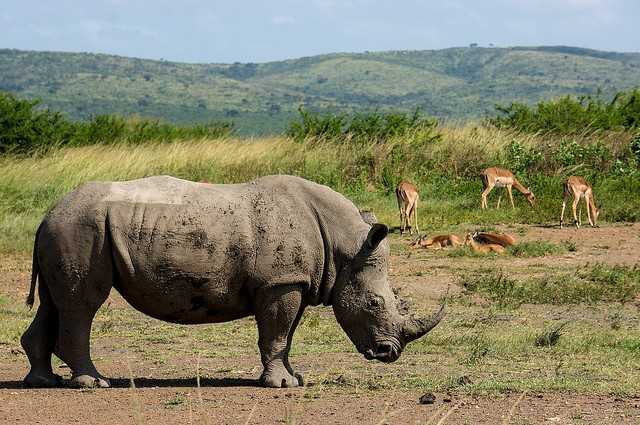300 km north of Durban, this reserve is known for its white rhinoceros protection program and now has about 90% of the world's rhinos. The Hluhluwe fauna includes 80 varieties of mammals (rhinos, lions, elephants, giraffes, cheetahs, leopards, antelopes...) and 425 species of birds. You can stay in the heart of the reserve or outside. The park can be visited all year long and always reserves discoveries.
This reserve, located about 7 hours’ drive from Johannesburg, can be visited along a route to Durban and / or its north coast (Maputaland, iSimangaliso Wetland Park...) and return via Swaziland or Drakensberg
Here, the testimonies of the ancient Zulu kingdom are still present and it is possible to visit a kraal (traditional Zulu village) in which the culture and customs of the largest ethnic group of South Africa are exposed. The main asset of this Zulu land is its incredible diversity, totally in the image of South Africa, the rainbow nation: an exceptional wild life, in particular the possibility to see the Big Five as rare marine species, a rich history (with the presence of important battle site), fabulous hiking opportunities and attractive seaside resorts to indulge in surfing or lazing around.
Advice:
- Diving: jewel of the South Coast, Alival Shoal is considered one of the best dive site in the world. The relief, the caves and the highland picks are home to wrecks, rays, turtles, bull sharks, tropical fishes and soft corals. The area of Sodwana Bay / Kosi Bay is also famous for diving…
- Marine Turtles: The Leatherback and the Loggerhead sea turtles elected as breeding area a zone that stretches from St Lucia Estuary north to Mozambique. They lay at night in summer and some 70 days later, the young hatch and rush to the sea…a striking and unique spectacle to observe between November and March…
- Seaside and fun stay with children : the Ballito area, Salt Rock doesn’t have much to do with the Zululand since it has seaside resorts without much interest but a stay of a few days or a week with young children can prove very pleasant : swimming facilities, games and activities for children… moreover, you can go very quickly towards north to admire mangrove nature reserves and to Durban to enjoy the city, its aquarium and attached amusement park… not to neglect so!
- Travel: the roads are generally good and car rental companies are numerous. Beware, some roads in iSimangaliso may require a 4x4.
- To get to Durban or the area from Johannesburg it takes a day (6/8 hours’ drive): useful and pleasant steps in the Drakensberg to predict or even in Swaziland or south of it if you want to go to Kosi Bay / Sodwana Bay.
South Africa, the 'rainbow' nation.
South Africa is so diverse you feel like you are visiting several countries in one trip!
With grandiose and various landscapes (mountains, « bush », beaches, forests, plains, desert), a pleasant climate in all seasons, an abundant and diversified fauna and flora including the “Big Five”, a population with the most composite ethnic groups, South Africa accumulates important natural wealth. Also note among its assets: quality of the hotel sector, services, road network, means of transport, rich and varied gastronomy, excellent wines, favourable exchange rates, 21 national parks and many private reserves, a multitude of activity throughout the country…
When to go?
South Africa has this peculiarity of presenting a wide variety of climates: Mediterranean, subtropical or temperate depending on the region with a high rate of sunshine everywhere (watch out for sunburn!)
South Africa can be visited all year round with more favourable periods depending on interests:
-
June, July and August (South African winter) for animals and therefore preferably the North of the country.
-
September and October: best times for flowers (Namaqualand) but very good for game drives as well.
-
From November to March (South African summer): best time to enjoy the South and East of the country, beaches of the Cape and the Indian Ocean. The Garden Route is particularly appreciated in February: the weather is nice; the temperature of the water is pleasant.
-
April and May: very pleasant autumn with always nice days in Cape Town and the resumption of the animal season.
Formalities:
The passport must include two blank pages and still be valid for 30 days after the expected date of exit from South Africa.
French nationals are exempted from prior visas. A 90-day residence permit will be issued at the border on entry into South African territory.
For other nationalities, inquire on a case-by-case basis with the competent authorities of their country of origin.
For any minor child: a multilingual extract of birth certificate (or an unabridged birth certificate translated into English - certified translation) is required to enter and leave South Africa (in the case of a child traveling with his 2 parents). Please consult the official sites for more information about all the requested documents according to your case.
Health:
No vaccinations are required for entry into South Africa. However, it is advisable to check the updating of your usual reminders and vaccinations as for any country.
Anti-malarial treatment is recommended (see your doctor).
Currency:
The Rand is the official currency of South Africa (symbol: ZAR). Credit cards are accepted everywhere and distributors are easily available for cash withdrawal. Travellers’ checks in euros are also accepted in banks and some hotels.
